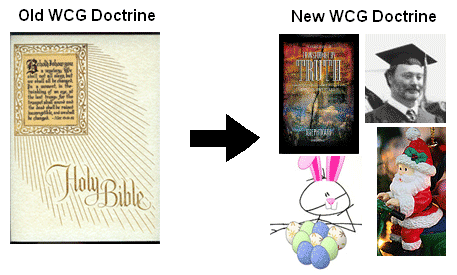Do You Know Gregory Thaumaturgus’ Impact on Beliefs & History?
Saturday, November 17th, 2012
November 17th is observed by some Greco-Roman Catholics in honor of the third century bishop known as Gregory Thaumaturgus, whom they also call saint Gregory of Neocaesarea.
Although I had heard of him years ago, until I was doing research for the book Fatima Shock!, I had not realized how much he affected the history of the Greco-Roman churches, as well as to some degree, the Church of God.
Around 238-244 A.D. Gregory (died roughly 270 A.D.) seems to have been the first to have claimed to have seen an apparition of Mary. This apparition allegedly appeared to him before he became a bishop. Gregory is also known as “Gregory the Wonder Worker” and Saint Gregory Thaumaturgus (wonder worker). He had been trained by allegorical teacher Origen in Alexandria.
Related to Gregory, Roberts and Donaldson reported:
He was believed to have been gifted with a power of working miracles, which he was constantly exercising…the demons were subject to him…he could cast his cloak over a man, and cause his death…he could bring the presiding demons back to their shrine.
Because Gregory’s power over demons and other “wonders” were apparently accepted by many, he had influence. It seems that Gregory’s enchantments and/or sorceries (cf. Isaiah 47:5-12; Nahum 3:4), along with Imperial persecutions, may have greatly assisted the Greco-Roman faction essentially eliminating the organized faithful in Asia Minor. Gregory was also a factor in the Marian cults that began to rise up around that time. His writings teach praise and excessive devotion to the “Holy Virgin,” including the blasphemous teaching that Mary “blotted out” Eve’s “transgressions.” He was amongst the earliest ones to promote the expression the “Holy Trinity” and the pagan idea idea that humans had an immortal soul.
Here the mystery of the Holy Trinity was revealed by the archangel to the Holy Virgin according to the gospel (Gregory Thaumaturgus, Homily concerning the Holy Mother of God, Section 35. Translated from the Armenian by F. C. CONYBEARE The Expositor 5th series vol.3 (1896), p. 173. http://www.tertullian.org/fathers/gregory_thaumaturgus_homily.htm viewed 11/13/12).
We prove, then, that the soul is simple…that what is simple is immortal…If, therefore, the soul is not corrupted by the evil proper to itself, and the evil of the soul is cowardice, intemperance, envy, and the like, and all these things do not despoil it of its powers of life and action, it follows that it is immortal. (Gregory Thaumaturgus. On the Soul, Chapters 5, 6. Translated by S.D.F. Salmond. From Ante-Nicene Fathers, Vol. 6. Edited by Alexander Roberts, James Donaldson, and A. Cleveland Coxe. Buffalo, NY: Christian Literature Publishing Co., 1886. Revised and edited for New Advent by Kevin Knight. <http://www.newadvent.org/fathers/0608.htm> viewed 06/05/11)
The gospel never uses the expression trinity, much less “Holy Trinity” nor does it teach that the soul is immortal (to the contrary, in Ezekiel 18:4 the Roman Catholic Douay-Rheims Bible teaches ” the soul that sinneth, the same shall die” and “The soul that sinneth, the same shall die” in Ezekiel 18:20), but Gregory put his own interpretation on scripture (in the trinity case, he was referring to Luke 1:35; and the immortality of the soul he did not cite scripture). Gregory was a major reason that the trinity started to get accepted much outside of Montanist circles (Origen, too, was a factor).
The Catholic Encyclopedia claims Gregory the Wonder worker developed the first creed with the word meaning “Trinity”:
The first creed in which it appears is that of Origen’s pupil, Gregory Thaumaturgus. In his Ekthesis tes pisteos composed between 260 and 270, he writes:
There is therefore nothing created, nothing subject to another in the Trinity: nor is there anything that has been added as though it once had not existed, but had entered afterwards: therefore the Father has never been without the Son, nor the Son without the Spirit: and this same Trinity is immutable and unalterable forever (P.G., X, 986).
It is manifest that a dogma so mysterious presupposes a Divine revelation.
The last statement should give many pause as it was allegedly from seeing one or more apparitions of Mary (and supposedly the Apostle John) that Gregory the Wonder Worker gained his “revelations.” Gregory was a supporter of Rome and Alexandria was a major factor in spreading more acceptance of the trinitarian position, especially throughout Asia Minor and Antioch.
Because of his “miraculous abilities,” his ideas apparently had more acceptance than what the Bible taught, and many were adopted. Noticed something else he wrote:
O holy virgin…She is the ever-blooming paradise of incorruptibility, wherein is planted the tree that giveth life, and that furnisheth to all the fruits of immortality…Thus the holy Virgin, while still in the flesh, maintained the incorruptible life…the holy Virgin has surpassed even the perfection of the patriarchs (Gregory Thaumaturgus. The Second Homily on the Annunciation to the Holy Virgin Mary. http://www.tertullian.org/fathers2/ANF-06/anf06-24.htm#TopOfPage viewed 11/13/12)
The Bible does not teach that Mary led an “incorruptible life.” The Bible teaches that all have sinned (Romans 3:23), except Jesus (Hebrews 4:14-15). Stating or implying that Mary did not is in biblical error. Perhaps it should be added that Dr. Ludwig Ott’s 20th century book Fundamentals of Catholic Dogma teaches:
The doctrine of the Immaculate Conception of Mary is not explicitly revealed in scripture… Neither the Greek nor the Latin Fathers explicitly (explicite) teach the Immaculate Conception of Mary. (Ott L. L. Fundamentals of Catholic Dogma, 4th ed . TAN Books, Rockford (IL), Nihil Obstat: Jeremiah J. O’ Sullivan. Imprimatur: + Cornelius, 7 October 1954., Printed 1974, TAN Books, pp. 200-201)
But it was more than Marian ideas that Gregory Thaumaturgus influenced.
Bishop “Gregory the Wonder Worker” was involved in the councils looking into Paul of Samosata who at the time was considered the Greco-Roman Bishop of Antioch (Roberts A, Donaldson J, Volume 20, p. 3).
Gregory assisted in getting Greco-Roman influence to succeed there. The Prophet Isaiah warned that the “Lady of the Kingdoms” used sorceries since her “youth” (Isaiah 47:5,12), and Gregory’s use of “powers” in the formative years of the Greco-Roman confederation seems consistent with that biblical prophecy (he also had influence in various parts of Asia Minor (Gregory Thaumaturgus. Canonical Epistles IV,VII. Ante-Nicene Fathers; also Drijvers JW, Watt JW. Portraits of spiritual authority: religious power in early Christianity, Byzantium, and the Christian Orient, Volume 137 of Religions in the Graeco-Roman world. BRILL, 1999, pp. 107-108).
Actually, in Antioch with the successor to Paul of Samosata, we seem to see for the first time, a bishop outside of Italy that was apparently installed because of direction from the Church in Rome, and the mystic Gregory Thaumaturgus was involved in this. This, to a degree, marked a major expansion of influence of the Church of Rome outside of Italy (it also had some previous influence in Corinth).
The Catholic Encyclopedia credits his influence in expanding their church (which it calls “the Christian Church” below):
Among those who built up the Christian Church, extended its influence, and strengthened its institutions,…Gregory of Neocaesarea holds a very prominent place…To attract the people to the festivals in honour of the martyrs, we learn that Gregory organized profane amusements as an attraction for the pagans who could not understand a solemnity without some pleasures of a less serious nature than the religious ceremony.
Sadly, it is partially because of Gregory that “Christianity” took on more of the trappings of pagan worship and the Marian cults had been allowed to grow and flourish.
Gregory greatly influenced theological thought and several widely accepted false doctrines were originated and/or promoted by him. The fact that he reportedly caused the death of enemies by throwing his cloak upon them has not sufficiently diminished his influence–but should have.
For more information, please check out the following:
Fatima Shock! What the Vatican Does Not Want You to Know About Fatima, Dogmas of Mary, and Future Apparitions. Whether or not you believe anything happened at Fatima, if you live long enough, you will be affected by its ramifications (cf. Isaiah 47; Revelation 17). Fatima Shock! provides concerned Christians with enough Catholic-documented facts to effectively counter every false Marian argument.
Fatima Shock! YouTube Dr. Thiel highlights a few points of why no one would support Fatima, etc. as discussed in the documented book Fatima Shock!
Did Early Christians Believe that Humans Possessed Immortality? What does John 3:16, and other writings, tell us? Did a doctrine kept adopted from paganism?
Did the True Church Ever Teach a Trinity? Most act like this is so, but is it?
Mary, the Mother of Jesus and the Apparitions Do you know much about Mary? Are the apparitions real? What might they mean for the rise of the ecumenical religion of Antichrist? Are Protestants moving towards Mary? How do the Orthodox view Mary? How might Mary view her adorers?
Which Is Faithful: The Roman Catholic Church or the Genuine Church of God? Do you know that both groups shared a lot of the earliest teachings? Do you know which church changed? Do you know which group is most faithful to the teachings of the apostolic church? Which group best represents true Christianity? This documented article answers those questions. Português: Qual é fiel: A igreja católica romana ou a verdadeira igreja do deus? Tambien Español: ¿Que es fiel: La Iglesia Católica Romana o la Iglesia verdadera de Dios? Auch: Deutsch: Welches ist treu: Die römisch-katholische Kirche oder die Kirche Gottes Original?









